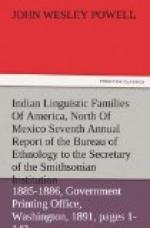Contrary to the popular opinion of the present day, the general trend of Siouan migration has been westward. In comparatively late prehistoric times, probably most of the Siouan tribes dwelt east of the Mississippi River.
The main Siouan territory extended from about 53 deg. north in the Hudson Bay Company Territory, to about 33 deg., including a considerable part of the watershed of the Missouri River and that of the Upper Mississippi. It was bounded on the northwest, north, northeast, and for some distance on the east by Algonquian territory. South of 45 deg. north the line ran eastward to Lake Michigan, as the Green Bay region belonged to the Winnebago.[86]
[Footnote 86: See treaty of Prairie du Chien, 1825.]
It extended westward from Lake Michigan through Illinois, crossing the Mississippi River at Prairie du Chien. At this point began the Algonquian territory (Sac, etc.) on the west side of the Mississippi, extending southward to the Missouri, and crossing that river it returned to the Mississippi at St. Louis. The Siouan tribes claimed all of the present States of Iowa and Missouri, except the parts occupied by Algonquian tribes. The dividing line between the two for a short distance below St. Louis was the Mississippi River. The line then ran west of Dunklin, New Madrid, and Pemiscot Counties, in Missouri, and Mississippi County and those parts of Craighead and Poinsett Counties, Arkansas, lying east of the St. Francis River. Once more the Mississippi became the eastern boundary, but in this case separating the Siouan from the Muskhogean territory. The Quapaw or Akansa were the most southerly tribe in the main Siouan territory. In 1673[87] they were east of the Mississippi. Joutel (1687) located two of their villages on the Arkansas and two on the Mississippi one of the latter being on the east bank, in our present State of Mississippi, and the other being on the opposite side, in Arkansas. Shea says[88] that the Kaskaskias were found by De Soto in 1540 in latitude 36 deg., and that the Quapaw were higher up the Mississippi. But we know that the southeast corner of Missouri and the northeast corner of Arkansas, east of the St. Francis River, belonged to Algonquian tribes. A study of the map of Arkansas shows reason for believing that there may have been a slight overlapping of habitats, or a sort of debatable ground. At any rate it seems advisable to compromise, and assign the Quapaw and Osage (Siouan tribes) all of Arkansas up to about 36 deg. north.
[Footnote 87: Marquette’s Autograph Map.]
[Footnote 88: Disc. of Miss. Valley, p. 170, note.]
On the southwest of the Siouan family was the Southern Caddoan group, the boundary extending from the west side of the Mississippi River in Louisiana, nearly opposite Vicksburg, Mississippi, and running northwestwardly to the bend of Red River between Arkansas and Louisiana; thence northwest along the divide between the watersheds of the Arkansas and Red Rivers. In the northwest corner of Indian Territory the Osages came in contact with the Comanche (Shoshonean), and near the western boundary of Kansas the Kiowa, Cheyenne, and Arapaho (the two latter being recent Algonquian intruders?) barred the westward march of the Kansa or Kaw.




